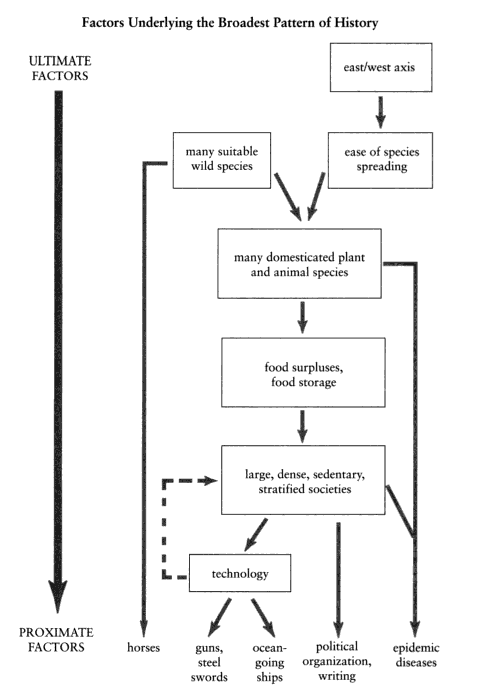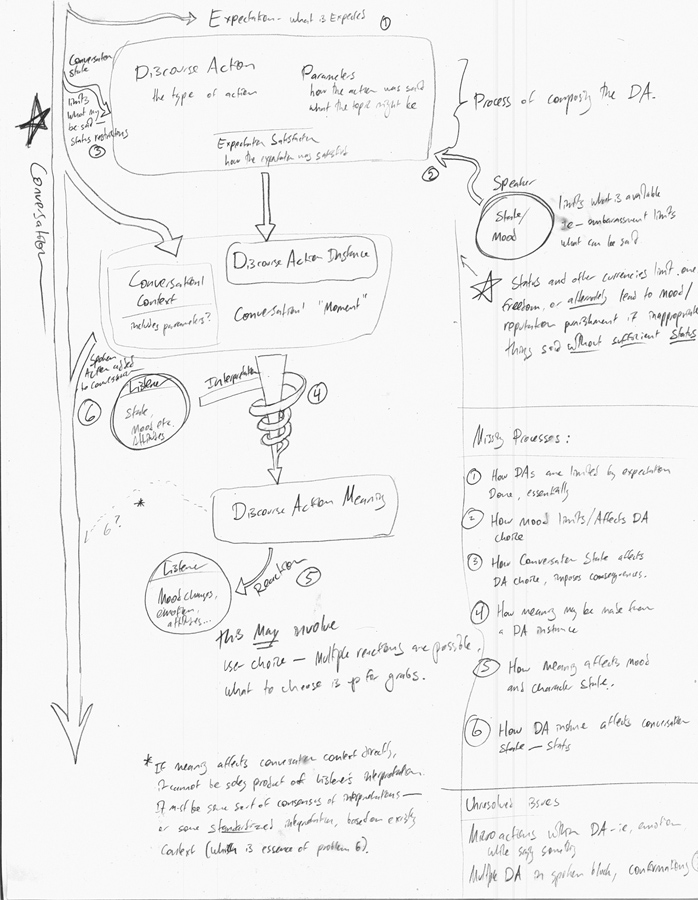Jared Diamond: Guns, Germs, and Steel
My interest in Diamond comes not from an anthropological perspective, but from a systemic one. Diamond is important because he gives an account of human history that focuses on the systems that give rise to current situations. This is presented as a gradual change from ultimate factors to proximal factors. The question Diamond seeks to answer in the book is why Western Europe came to dominate so much of the globe. Why didn’t the Incas sail to Europe and lay waste to the Spanish instead of the other way around? The arguments that are usually employed to explain and justify European expansion tend to involve such racist themes of inherent superiority of people. While these arguments are false and usually acknowledged to be so, they are often accepted subconsciously as folk explanations for history. Diamond first presses to look first at the direct causes for the domination (technology, ships, diseases, steel, horses, etc), but shows that these are not enough. Why did Europe develop guns and steel weaponry and not Polynesia? The ultimate causes for these can be traced back to environmental factors.
Diamond is relevant for three reasons. The first is that he presents a view of the world that is system focused, that views human history as an emergent system that is the product of rules and circumstances. The second is that the system perspective can be employed pedagogically, as a theory which can be used to empower students by offering an alternative to conventional theories. The third is that it can be used as an alternative model in other historical simulations, most notably it can be compared with the system of history presented in Sid Meier’s Civilization. Much of what I am interested in is using this to compare against Civilization, and to show how the models used in Civilization encourage the classic racist interpretations of history.
I am not alone in my interest in these comparisons. Ian Bogost makes an analysis of Jared Diamond as a procedural representation of history (both here and in his book Persuasive Games). There is also a now defunct group that has been interested in using Guns, Germs, and Steel as a model for Civilization IV, the most recent installment in the series, which offers an extensive modding platform. It is arguable, though, that such a model would not be successful as a game because of how inequality is a natural consequence of Diamond’s model. Ironically, in attempt to make the game fun and even, where all societies have an even chance, the game makes them assume the history of the colonizers.
A Natural Experiment of History
Diamond gives a small test of a larger hypothesis. He looks at a particular conflict within Polynesia, specifically between the Maori and Moriori in New Zealand. The latter lived in a constrained environment that prevented excessive growth, while the Maori grew, developed a population beyond what was needed for support, and fought internally. In the same pattern as other colonizing and expansionist forces throughout history, the Maori eventually found the Moriori and destroyed and enslaved them. This small encounter reveals a microcosm of patterns that emerged across the world.
On the whole, Polynesia is interesting because it contains an intense diversity of cultural groups, and an equal diversity of environments in which these groups reside. To examine the issue of Polynesian cultural diversity, Diamond looks at environmental differences, specifically the variables of climate, geological type, marine resources, area, terrain fragmentation, and isolation. An interesting detail about this is that these types of variables are things that are receptive to simulation. These are also variables that occur within the game Civilization, although the model of the game is constructed to give every player a roughly equally “valuable” exchange of these variables.
These environmental factors give way to first issues of sustinence, which can be expressed in what types and volumes of food are available, ranging from hunting and gathering, to domestication of animals and agriculture. This then leads directly to population density and size. The size of a population is dependent on the size of the political unit, which may be a single island, a part of a large island, or a cluster of islands. The political unit size is dependent on the isolation of the mass. The population size affects the number of potential non-producers. Non-producers are people who do not spend their time on sustenance, but can be chiefs and bureaucrats, craftsmen, artists, and so on. The number of these non-producers and the population size tends to lead to greater social complexity. Again, several of these factors are available in Civilization. The game has a model of producers versus non-producers, but this dimension is included in the model anyway. The important distinction is that Civilization takes size and complexity as assumptions, as inevitabilities.
Further factors emerge in the types of tools that are developed and used, which is dependent on the number of specialists, as well as the available materials. With large numbers of these, there can be ever greater production sizes, leading to the massive monuments at Easter, among others. These are dependent on the centrality of the political organization. The interesting dimension is that these types of monuments seem very reminiscent of other sorts of monuments in other cultures, notably the Egyptian pyramids. Diamond suggests that the size of the monuments is directly related to the scale of labor that the political leaders could draw from the population.
Collision at Cajamarca
Diamond in this section looks at the Spanish destruction of the Incas at Cajamarca, and the capture and ransom of Atahuallpa. He discusses the differences between the sides coming from their history. These differences are presented step by step through a series of questions. Why did Pizarro capture Atahuallpa? How did Atahuallpa come to be at Cajamarca? How did Pizarro come to be at Cajamarca? Why didn’t Atahuallpa instead try to conquer Spain? Why did Atahuallpa walk into the trap? These each depend on some particular difference between the forces. The Spanish captured Atahuallpa because of their guns, horses, and steel weapons and armor. The Incas were vulnerable because of civil conflicts and the smallpox epidemics spread by other Europeans. The Spanish invaded the Incas because of the massive political and economic infrastructure that enabled expansion. Writing and the literate tradition enabled Europeans to communicate their experiences with the Native Americans and make use of successful strategies in their bloody conquest.
What is remarkable about this is that each step is defined by an environmental difference, where the Inca civilization took one route and the Spanish took another. In Civilization the game, these steps are not assumed to yield differences. Instead, the course of history that the Spanish followed is the course that everyone must take in Civilization. Essentially, it assumes that all societies must inevitably develop the kind of power that colonizers have used to oppress others. In Civilization’s model of history where these steps are natural and inevitable, it would appear that the destruction of the Inca’s was their own fault, for not developing the technology and production that came so naturally to the Spanish. Civilization’s model is thus racist because it disregards the existence of other options in cultural development.
Farmer Power
The last thing I want to include is a handy picture of the transition from ultimate factors to proximate factors.

Ultimate to Proximate factors
| Author/Editor | Diamond, Jared |
| Title | Guns, Germs, and Steel: The Fates of Human Societies |
| Type | book |
| Context | Extremely useful for contrasting against the rhetoric of Civilization. |
| Tags | specials, media theory, anthropology |
| Lookup | Google Scholar, Google Books, Amazon |


